Masterpieces of Architecture
Day 1: Arrival in Tashkent
We'll pick you up at the airport and take you to your hotel to rest and relax after your long journey.
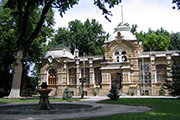
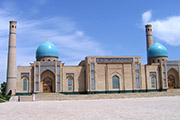
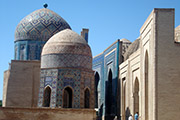
Day 2: Introduction to Tashkent, then on to Samarkand
After breakfast today, we will visit the Museum of Applied Art of Uzbekistan, housed in a restored pre-revolution mansion once owned by the wealthy St. Petersburg aristocrat and statesman Alexander Polovtsov. Among the collections in this museum are silk embroidery, called suzani; musical instruments; ceramics and porcelain; decorative wood carving and of course, silks, carpets and other textiles. All of these traditional arts are still alive and well in Uzbekistan so what you see and learn about in the museum today, you will also see and recognize in other forms as you travel through our country.
We will also escort you on a sightseeing tour of the historic old part of our nation's capital. Even though the areas of our city that you saw on your drive from the airport yesterday look modern, Tashkent's history goes back about 2,500 years. But this is an earthquake-prone region and unfortunately for many of our ancient landmarks, in 1966, a devastating earthquake destroyed much of the city. It took decades to restore some of our masterpieces of medieval Islamic architecture to their former glory but we think you'll agree that the results have been worth the effort.
You’ll have more time to spend in Tashkent at the end of your tour but this afternoon, we’ll board our bus for Samarkand, a 300-km drive that takes about four hours. After checking into our hotel, we’ll have dinner.
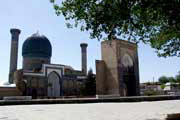
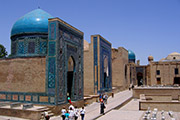
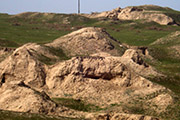
Day 3: Samarkand
Prepare to be dazzled by the splendour of a city which is often called one of architectural wonders of the world. In 1370, Tamerlane decided to make Samarkand his imperial capital. To that end, he brought in the greatest artisans and craftsmen from all over his vast empire to turn his dream into reality.
Today's Samarkand is believed to be very close to Tamerlane's vision but photographs taken in the early 20th century show these monumental buildings in an advanced state of disrepair, the elaborate tilework all but gone in many places. In recent years, massive restoration projects have transformed the interiors and exteriors of mosques, madrassahs and mausoleums and this work is still in progress.
A number of colourful legends surround the story of the creation of one of Samarkand's architectural highlights, the Mosque of Bibi-Khanum, but the most credible is that Tamerlane ordered it built and named it after his favourite wife, a Mongolian princess.
Today, you'll also get the chance to pay your respects to Tamerlane himself, where he rests, along with various relatives, under the golden dome of the fabulous Gur-i Amir mausoleum.
You’ll also visit the Shakh-i-Zinda necropolis, a complex consisting of mosques and eleven mausoleums constructed in the 14th and 15th centuries to house the remains of members of the royal family and other nobles.
Ulugh Beg, a grandson of Tamerlane who ruled over the lands known as Transoxiana from 1409 to 1449, commissioned the Ulugh Beg Observatory, a three-storey, cylinder-shaped building constructed around three huge astronomical instruments. The largest of these, a curving stone arch called the Fakhri sextant, was used to measure the angle of elevation of celestial bodies, allowing astronomers to calculate the length of a year to within 25 seconds – almost 200 years before telescopes were invented! After Ulugh Beg's death, the observatory was destroyed by religious fanatics but rediscovered in 1908 by Russian archaeologist Vassily Vyatkin. This discovery meant so much to Vyatkin that he asked to be – and is -- buried on the site.
More ancient tombs, including one believed to hold the remains of the Old Testament prophet Daniel, are located in the nearby town of Afrasiab. While there, we'll also visit a workshop specializing in hand-woven silk carpets.



Day 4: To Bukhara via Shahrisabz
After breakfast, we'll board the bus for Tamerlane's home town, Shahrisabz (also spelled Shahkrisabz and Shakhrisyabz), all versions meaning “green city.” Tamerlane was so fond of his city, known in ancient times as Kesh, that under his and his successors' patronage in the 14th and 15th centuries, it became the region's cultural and political hub. In 1380, the emperor sent to Shahrisabz some of the master artisans he'd imported from around his empire and there, they created his Ak-Sarai Palace.
Like most of the grand buildings and monuments you'll visit throughout this tour, Ak-Sarai Palace has been designated a UNESCO World Heritage site. The Paris-based United Nations agency has this to say about it: “Although Samarkand may boast a great many Temurid monuments, not one can rival the Ak-Sarai Palace in Shakhrisyabz. The foundations of its immense gate have been preserved: this architectural masterpiece is outstanding in its dimensions and bold design.”
You’ll also see the Dorus Saodat mausoleum complex, where Tamerlane’s two eldest sons, Jehangir and Omar Sheikh, are interred.
We'll arrive in Bukhara in the evening and after we check into the Hotel Emir, have dinner.
Did you know? During his lifetime, nobody who defied Tamerlane would have lived to tell the tale but one very spooky story suggests that not even death put an end to the vast power he wielded. In 1405, the year he died of pneumonia on his way to conquer China, an Arabic inscription was carved into his tomb saying that anyone who dared to disturb his rest could look forward to dealing with enemy invaders even fiercer than Tamerlane himself.
But this did not deter one of Tamerlane's greatest admirers -- Soviet dictator Joseph Stalin, who wanted to know what Tamerlane had looked like. To that end, he sent an expedition led by anthropologist Mikhail Gerasimov, who had famously managed to reconstruct an entire face using a only skull, with orders to exhume Tamerlane and his grandson, Ulugh Beg, and bring the remains back to Moscow.
Ignoring the objections of local people in Samarkand, Gerasimov opened the tomb on June 20, 1941. Two days later, Nazi Germany invaded Russia. In 1942, not long after the bones of Tamerlane and Ulugh Beg were reinterred with full Islamic funeral rites, the Germans surrendered at Stalingrad after one of the bloodiest battles in the history of warfare, the Red Army toll of dead, wounded, missing or captured soldiers estimated at about 1.1 million.

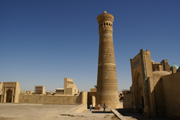
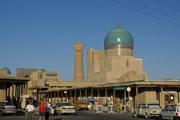
Day 5: Bukhara Sharif
Since Emir Travel and Hotel Emir are both in Bukhara, we freely admit to having a bias in favour of our ancient city, once one of the most renowned centres of learning and culture in the Islamic world. For our visitors, one of the greatest charms of our Old City is that almost everything worth seeing and experiencing, including shops, restaurants, covered bazaars and of course, our monumental buildings, is within easy walking distance.
Sharif, meaning 'noble' in Arabic, is a designation bestowed only on a handful of cities, Mecca and Medina among them, with special religious importance in Islam. Bukhara earned its sharif status as the 9th century birthplace of Imam al-Bukhari, one of the greatest collectors of written hadith -- sayings or anecdotes attributed to the Prophet Muhammad. For generations before al-Bukhari`s lifelong work, these stories had only been passed down orally.
Today, you'll see the majestic Kalyan minaret, the symbol of our city. It was built in 1121 but a century later, after Bukhara was sacked by Genghis Khan and his army, legend has it that the Mongol emperor was so impressed that he ordered our great minaret spared while everything else around it was destroyed, including the original mosque. That’s why the mosque and the madrassah now facing each other across the square both date from the 16th century.
Some time in the 1800s, one of Bukhara's cruelest emirs, Nasrullah Khan, ordered a man charged with defacing the minaret to be thrown from the top of it. However, our historians say that there's no truth to the widely-believed “Tower of Death” story that executions such as this took place regularly. After all, five times every day, a muezzin had to climb up and down the 104 steps of the interior spiral staircase to summon the faithful to prayer.
In Soviet times, Bukhara downplayed the most poignant historical aspect of a residence that used to be known only as “a rich merchant's house.” In fact, the merchant who once owned it, a dealer in the pelts of karakul sheep (called Persian lamb in the West), was the father of Faizullah Khojaev, who was a controversial figure to Bukharans. Khojaev, the leader of a dissident group that helped the Red Army overthrow the last emir of Bukhara in 1920, became the first president of what was then called the Bukharan People's Soviet Republic.
But like many other people of his day, Khojaev ran afoul of Joseph Stalin and, after a show trial in Moscow, was executed by firing squad on March 13, 1938, his 42nd birthday. His mother, sister, wife and daughter were all exiled to a prison camp in Siberia, although his mother died enroute. Khojaev was rehabilitated in 1966 and today, the house where he once lived now contains much of his personal and family memorabilia.
While there, you'll also see displays of the traditional clothing worn by Uzbek people before the 1920 revolution, including paranjas, the all-obscuring veil that Bukharan women were required to wear in public.
Day 6: More to admire about Bukhara
After breakfast, we begin the day with a visit to the Ark Fortress Museum. Sadly, this massive structure, known to have existed there in some form for more than 2,000 years, has suffered a great deal of damage over the years, most recently after a buildup of ice and snow caused part of the roof over the entrance to collapse. But before the revolution in 1920, the Ark was the centre of government for the entire emirate of Bukhara and also housed the main palace of the last emir of Bukhara, Said Alim Khan. Today, the rooms open to the public house historical displays.
Some of the area of Registan Square in front of the Ark had to be sacrificed when roads were widened, so it used to be much larger. Here, Bukharans used to gather to watch entertainments such as wrestling, jugglers, trapeze artists – as well as public floggings and executions.
Sites of interest near the fortress include the remains of the walls that used to encircle the city, with doors that were closed, locked and barred to all non-residents after dark; the Bolo-Khauz complex, consisting of a reservoir, mosque and minaret; and the intriguing Chashma-Ayub (Job's Well) shrine and mausoleum.
According to legend, long ago, the prophet Job, whose tale of terrible suffering is told both in the Old Testament and the Qur'an, once visited what is now Bukhara during a drought. Distressed to learn that the people here didn't have enough drinking water, Job drove his staff into the ground, causing a stream of clean, clear water burst forth. Tamerlane ordered the construction of this building in the 14th century and local people still come here to collect the spring water, which is believed to have healing properties.
One of the oldest of Bukhara's monuments is the Samanid mausoleum, built between 892 and 943, to house the remains of Ismail Samani, an emir who ruled in Central Asia, and a few of his relatives.
The goodies on offer in our main bazaar, also in this immediate area, are likely to whet your appetite for lunch (if you haven't already ruined it by overindulgence in samples of the merchandise). In the afternoon, we'll visit the summer palace of the last emir of Bukhara, not far outside the city. Although this site had been used as a country estate by many previous emirs, this palace was completed in 1918, which allowed Alim Khan only two short years to enjoy it. There, you'll also see an exhibition of hand-stitched suzani.
After dinner, in the courtyard of the Divan Begi madrassah, an Uzbek Folklore ensemble will perform for you.
Day 7: From Bukhara to Khiva
The 450-kilometre road trip from Bukhara to Khiva takes 6 to 7 hours so we'll leave after breakfast but stop to have a picnic lunch near the banks of the Amu Darya River, called the Oxus in ancient times, arriving in the walled city in late afternoon. After we check into our hotel and have dinner, the rest of the evening is yours.
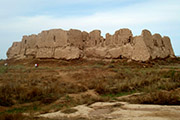

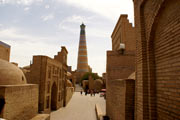
Day 8: A Walking Tour of Old Khiva
Unlike Tashkent, Samarkand and Bukhara, Khiva's old city is almost uninhabited. With 54 perfectly-preserved or restored historical buildings and monuments, including mosques, madrassahs, mausoleums, minarets and palace complexes, in so compact an area, it's almost like experiencing Samarkand in miniature. Highlights of the city include an underground mosque, the courtyard of the royal harem – and the unique symbol of the city, called Kalta Minor, meaning “short minaret” -- which looks much like an elaborately-decorated industrial chimney. And therein hangs a tale...
If this minaret had ever been finished, it might have been taller than Bukhara's Kalyan minaret and, according to one of several stories associated with it, this might be the reason why it wasn't. Historically, the khans of Khiva and the emirs of Bukhara, both rivals for influence in the region, were mortal enemies whose armies constantly waged war on each other. Allegedly, Khiva's Muhammad Amin Khan, who had ordered the construction of this minaret, meant for it to tower over Bukhara's minaret but when Bukhara's then-emir Nasrullah – the same emir, nicknamed “the Butcher,” who had ordered a man to be thrown to his death from the the Kalyan minaret -- got wind of this, he vowed it would never happen.
As the story goes, Nasrullah offered the minaret's architect more money if he'd abandon that project and build his mighty minaret in Bukhara – and the architect agreed. But when the Khivan khan found out about this double-cross, he put out a contract on the architect's life, who fled to save his own skin. Since there was no one else who could complete the job, work on the minaret ceased after the death of the Khivan khan in 1860, so what you see today is what it looked like then.
Day 9: From Urgench to Tashkent
After breakfast, we depart Khiva for the short drive to the city of Urgench, and from the airport there, fly to Tashkent and check into our hotel there. This afternoon, if you still have sums left, the merchandise in Chorsu Bazaar in the Old City will provide you with many ideas for spending them. The main difference between this bazaar and many other markets and vendors you’ve seen in Uzbekistan is that the merchants of Chorsu Bazaar don’t cater mainly to tourists but rather a demanding local clientele, which often translates to higher quality and lower prices than merchandise intended for the tourist trade. In the evening, we’ll attend a performance of the Navoi Opera and Ballet Theatre.
Day 10: Farewell to Uzbekistan
We hope that you've enjoyed your time with us as much as we've enjoyed our time with you. Remember that international protocol requests your presence at the airport for registration at least three hours before your flight is scheduled to depart.

